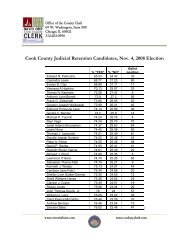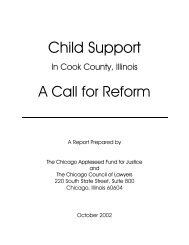Videoconferencing in Removal Hearings: A Case Study of the ...
Videoconferencing in Removal Hearings: A Case Study of the ...
Videoconferencing in Removal Hearings: A Case Study of the ...
Create successful ePaper yourself
Turn your PDF publications into a flip-book with our unique Google optimized e-Paper software.
The <strong>in</strong>terpreter was located <strong>in</strong> <strong>the</strong> courtroom or translated by phone (phone<br />
translation is <strong>the</strong> rule <strong>in</strong> <strong>the</strong> case <strong>of</strong> languages o<strong>the</strong>r than Spanish). In <strong>the</strong> few hear<strong>in</strong>gs<br />
we observed with non-Spanish <strong>in</strong>terpreters, we saw serious problems. One observer<br />
reported that four Mandar<strong>in</strong>-speak<strong>in</strong>g immigrants had a group hear<strong>in</strong>g, and that it was<br />
“chaotic.” On five occasions, observers reported that <strong>the</strong> court seemed reluctant to use an<br />
<strong>in</strong>terpreter, even when it appeared that <strong>the</strong> immigrant could not understand everyth<strong>in</strong>g<br />
that was said <strong>in</strong> <strong>the</strong> courtroom. One observer described <strong>the</strong> case <strong>of</strong> an Arabic-speak<strong>in</strong>g<br />
immigrant: “The immigrant spoke English, but imperfectly. He told long, somewhat<br />
jumbled stories. His lawyer requested an <strong>in</strong>terpreter and <strong>the</strong> judge deemed it<br />
unnecessary.” In o<strong>the</strong>r cases, observers made comments like <strong>the</strong> follow<strong>in</strong>g: “There was<br />
no <strong>in</strong>terpreter and I got no sense that <strong>the</strong> immigrants understood what was go<strong>in</strong>g on.”<br />
A few attorneys discussed <strong>the</strong>ir frustration with <strong>the</strong> <strong>in</strong>terpretation procedures.<br />
Some attorneys compla<strong>in</strong>ed about <strong>the</strong> distance between <strong>the</strong> <strong>in</strong>terpreter and <strong>the</strong> immigrant.<br />
Two attorneys mentioned that <strong>in</strong>terpretation over <strong>the</strong> phone was <strong>of</strong>ten difficult or<br />
“messy,” and o<strong>the</strong>rs suggested hav<strong>in</strong>g <strong>the</strong> <strong>in</strong>terpreter at Broadview. However, as one<br />
attorney po<strong>in</strong>ted out, most attorneys have limited foreign language abilities, and <strong>the</strong>y are<br />
<strong>of</strong>ten not able to evaluate <strong>the</strong> effectiveness <strong>of</strong> any <strong>in</strong>terpretation. We suggest that <strong>the</strong><br />
immigrants <strong>the</strong>mselves, and possibly <strong>the</strong> <strong>in</strong>terpreters, would be <strong>the</strong> best sources for more<br />
<strong>in</strong>formation about how videoconferenc<strong>in</strong>g affects courtroom <strong>in</strong>terpretation.<br />
The Presentation <strong>of</strong> Evidence and Testimony<br />
Problems concern<strong>in</strong>g <strong>the</strong> presentation <strong>of</strong> evidence and testimony were relatively<br />
common <strong>in</strong> our observed hear<strong>in</strong>gs – about one <strong>in</strong> six immigrants experienced some type<br />
44




